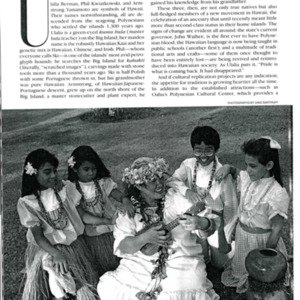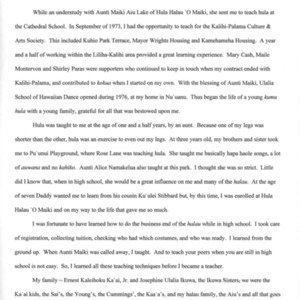Ulalia Ka‘ai Berman
Title
Ulalia Ka‘ai Berman
Subject
Nā Kumu Hula Ulalia Ka‘ai Berman - Nānā I Nā Loea Hula Volume 2 Page 19
Description
Ulalia Berman, a resource teacher with Department of Education, Hawaiian Studies-Kupuna Program, is kumu hula of Ulalia Hawaiian School of Dance located in Kailua-Kona.
Hula was taught to me at the age of one and a half years by an aunt. Because one of my legs was shorter than the other, hula was an exercise to even out my legs. At three-years-old my brothers and sister took me to Puʻunui Playground where Bose Lane was teaching hula. She taught hapa haole songs, a lot of ʻauana, and no kahiko. Aunti Alice Nāmakelua also taught at this park. I thought she was so strict. Little did I know that she would be a great influence on me and many of the hālau. At the age of seven Daddy wanted me to learn from his cousin Kuulei Stibbard but by this time, I was enrolled at Hula Hālau ʻO Māʻiki and on my way to the life that gave me so much.
I was fortunate to have learned how to do the business end of the hālau while in high school. I took care of registration, collecting tuition, checking who had which costumes, and who was ready. I learned from the ground up. When Aunti Māʻiki was called away, I taught for her. And to teach your peers when you are still in high school is not easy. So I learned all these teaching techniques before I became a kumu.
The teachings of Aunti Māʻiki enriched us all as she shared the love of her mentors. We were surrounded with people and love for all that life has to offer. I have so many memories of concerts, lūʻau shows, boat arrivals and departures, Aloha Week, and holokū balls. We were one of the first young children to dance in what is known today as the “Gibson Mūʻū.” Everyone called them pajamas. But Aunti Vicky Iʻi gave Aunti Māʻiki that high neck “Mother Hubbard” style and it became an insignia for the hālau. And of course we would perform with hula skirts made with one hundred fifty ti leaves, two pua melia lei and a head lei, or cellophane skirts, or red and white sarongs that people called the “Dorothy Lamour look.”
When I moved back to Honolulu from Kona, Aunti Māʻiki bad started a kumu class. The only requirement was the student’s desire to learn. Having a young family at that time, I didn’t know what my goals were. I couldn’t envision where I was going to be years down the road. At times it shocked me that I was studying to become a kumu hula. But on August 27, 1973 I ʻūniki as ʻōlapa with Aunti Māʻiki and the following year I finished as kumu hula along with the Papa Lehua class.
While an understudy with Aunti Māʻiki I was sent to teach hula at the Cathedral School. In September of 1973 I had the opportunity to teach for the Kalihi-Pālama Culture & Arts Society in community facilities located in the Kūhiō Park Terrace, Mayor Wrights Housing and Kamehameha Housing. A year and a half of working within the Liliha - Kalihi area provided a great learning experience. With the blessings of Aunti Māʻiki, Ulalia School of Hawaiian Dance opened in 1976 at my home in Nuʻuanu. Thus began the life of a young kumu hula with a young family, grateful for all that was bestowed upon me.
Life, fulfillment, enrichment. That’s the meaning of being a kumu hula and my kumu Aunti Māʻiki had all of these. She not only taught us about hula, she taught us about life. She shared the ups and downs because it was part of life. It’s harder to be a kumu hula today because we have to be “on top of everything” w hereas while studying with Aunti Maʻiki, we took one thing at a time; a program for Tripler Army Hospital this w7eek and a program for Aunti Bina Mossman next week.
I am honored when people recognize Aunti Māʻiki’s style when my haumāna dance the hula. Though I’m sure I have developed a few of my own motions over the years, I still come from the hālau of Aunti Māʻiki and I continue her style.
I give credit to my husband Kona and our children Kaleihoku-o-kona, Analu Kaʻai, Hoʻolaikahiluonalani, and Lononuiakea for their continued support. I’m proud to know that Hoʻolai and Lono carry on our rich legacy of Ilawaiʻi through music, dance, language, and love for cultural awareness. Kona and I pass on our love so they may continue to enrich future generations. E ola mau!
"Life, fulfillment, enrichment. That is the meaning of being a kumu hula and my kumu Aunti Māʻiki had all of these. ”
Hula was taught to me at the age of one and a half years by an aunt. Because one of my legs was shorter than the other, hula was an exercise to even out my legs. At three-years-old my brothers and sister took me to Puʻunui Playground where Bose Lane was teaching hula. She taught hapa haole songs, a lot of ʻauana, and no kahiko. Aunti Alice Nāmakelua also taught at this park. I thought she was so strict. Little did I know that she would be a great influence on me and many of the hālau. At the age of seven Daddy wanted me to learn from his cousin Kuulei Stibbard but by this time, I was enrolled at Hula Hālau ʻO Māʻiki and on my way to the life that gave me so much.
I was fortunate to have learned how to do the business end of the hālau while in high school. I took care of registration, collecting tuition, checking who had which costumes, and who was ready. I learned from the ground up. When Aunti Māʻiki was called away, I taught for her. And to teach your peers when you are still in high school is not easy. So I learned all these teaching techniques before I became a kumu.
The teachings of Aunti Māʻiki enriched us all as she shared the love of her mentors. We were surrounded with people and love for all that life has to offer. I have so many memories of concerts, lūʻau shows, boat arrivals and departures, Aloha Week, and holokū balls. We were one of the first young children to dance in what is known today as the “Gibson Mūʻū.” Everyone called them pajamas. But Aunti Vicky Iʻi gave Aunti Māʻiki that high neck “Mother Hubbard” style and it became an insignia for the hālau. And of course we would perform with hula skirts made with one hundred fifty ti leaves, two pua melia lei and a head lei, or cellophane skirts, or red and white sarongs that people called the “Dorothy Lamour look.”
When I moved back to Honolulu from Kona, Aunti Māʻiki bad started a kumu class. The only requirement was the student’s desire to learn. Having a young family at that time, I didn’t know what my goals were. I couldn’t envision where I was going to be years down the road. At times it shocked me that I was studying to become a kumu hula. But on August 27, 1973 I ʻūniki as ʻōlapa with Aunti Māʻiki and the following year I finished as kumu hula along with the Papa Lehua class.
While an understudy with Aunti Māʻiki I was sent to teach hula at the Cathedral School. In September of 1973 I had the opportunity to teach for the Kalihi-Pālama Culture & Arts Society in community facilities located in the Kūhiō Park Terrace, Mayor Wrights Housing and Kamehameha Housing. A year and a half of working within the Liliha - Kalihi area provided a great learning experience. With the blessings of Aunti Māʻiki, Ulalia School of Hawaiian Dance opened in 1976 at my home in Nuʻuanu. Thus began the life of a young kumu hula with a young family, grateful for all that was bestowed upon me.
Life, fulfillment, enrichment. That’s the meaning of being a kumu hula and my kumu Aunti Māʻiki had all of these. She not only taught us about hula, she taught us about life. She shared the ups and downs because it was part of life. It’s harder to be a kumu hula today because we have to be “on top of everything” w hereas while studying with Aunti Maʻiki, we took one thing at a time; a program for Tripler Army Hospital this w7eek and a program for Aunti Bina Mossman next week.
I am honored when people recognize Aunti Māʻiki’s style when my haumāna dance the hula. Though I’m sure I have developed a few of my own motions over the years, I still come from the hālau of Aunti Māʻiki and I continue her style.
I give credit to my husband Kona and our children Kaleihoku-o-kona, Analu Kaʻai, Hoʻolaikahiluonalani, and Lononuiakea for their continued support. I’m proud to know that Hoʻolai and Lono carry on our rich legacy of Ilawaiʻi through music, dance, language, and love for cultural awareness. Kona and I pass on our love so they may continue to enrich future generations. E ola mau!
"Life, fulfillment, enrichment. That is the meaning of being a kumu hula and my kumu Aunti Māʻiki had all of these. ”
Citation
“Ulalia Ka‘ai Berman,” Nā Kumu Hula Archive, accessed August 25, 2025, https://nakumuhula.org/archive/items/show/107.











